What is the Most Important Continuity Since the Postclassical Era

To a large degree, the Classical Era set the stage -- it introduced cultural trends, the major religious beliefs systems for many major regions and started inter-regional trade patterns. What happens, though, when all the largest empires fall? Welcome to the Post-classical time period . . . When Muslims and Mongols take center stage. There are some reconstituted empires from previous time periods (think Byzantines and Tangs), and some Feudal developments in Europe and Japan and some empires worth discussing in the Americas (i.e. the Aztecs and Incas) but Islam dominates the imperial and trade aspects of the Postclassical time period. The Indian Ocean is also super important in a way that we will call "Southernization" -- the world becoming more "Eastern". The Postclassical time period accounts for 20% of the AP Exam, so pay close attention to the following . . .
Unit III in Maps
Postclassical Major Empires and Cities

PostClassical Civilizations (6oo CE to 1450 CE)

PostClassical Era Trade Routes (by 1450 CE)

Postclassical Religious Diasporas

Europe in the Postclassical Time period



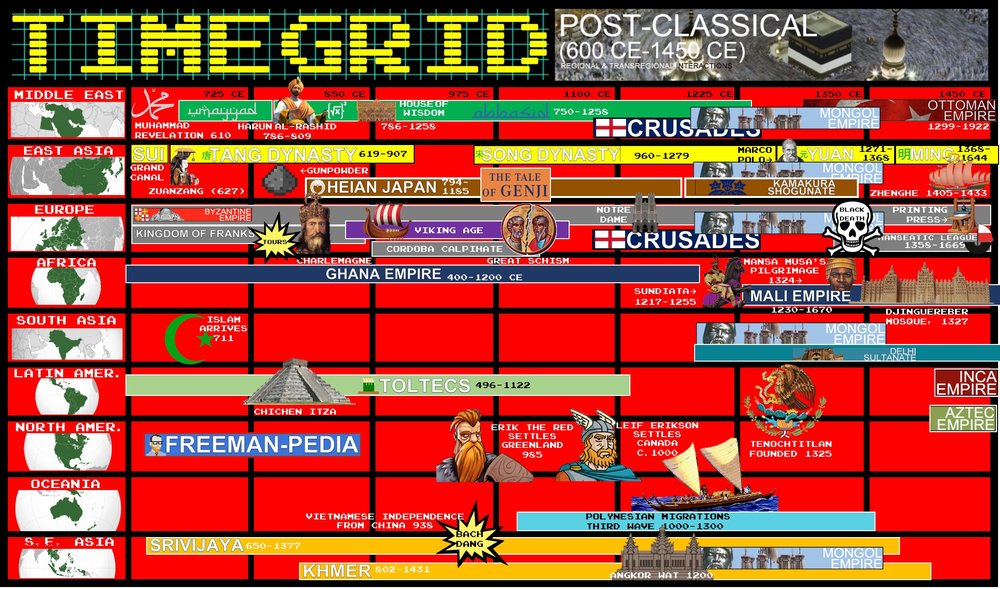
Unit III Key Concepts
The Postclassical Era => Regional and Transregional Interactions ca 600 C.E. to 1450 C.E.
KEY CONCEPT 3.1: EXPANSION & INTENSIFICATION of COMMUNICATION & EXCHANGE NETWORKS
Although Afro-Eurasia and the Americas remained separate from one another, this era witnessed a deepening and widening of old and new networks of human interaction within and across regions. The results were unprecedented concentrations of wealth and the intensification of cross-cultural exchanges. Innovations in transportation, state policies, and mercantile practices contributed to the expansion and development of commercial networks, which in turn served as conduits for cultural, technological, and biological diffusion within and between various societies. Pastoral or nomadic groups played a key role in creating and sustaining these networks. Expanding networks fostered greater interregional borrowing, while at the same time sustaining regional diversity. The prophet Muhammad promoted Islam, a new major monotheistic religion at the start of this period. It spread quickly through practices of trade, warfare, and diffusion characteristic of this period. (2012 CONTINUITIES & CHANGE ESSAY)
1. Improved transportation technologies and commercial practices led to an increased volume of trade, and expanded the geographical range of existing and newly active trade networks.

- The growth of inter-regional trade in luxury goods (silk and cotton textiles, porcelain, spices, precious metals and gems, slaves, exotic animals)

- Trade was encouraged by significant innovations in previously existing transportation and commercial technologies, including more sophisticated caravan organization (Caravanserai, Camel saddles);



- larger ship designs in sea travel; and new forms of credit and monetization (Bills of exchange, Credit, Checks, Banking houses).


- Commercial growth was also facilitated by state practices (Minting of coins, use of paper money)
- Trading organizations (HANSEATIC LEAGUE) and State-sponsored commercial infrastructures like the Grand Canal in China.


-
The expansion of EMPIRES facilitated Trans-Eurasian trade and communication as new peoples were drawn into their conquerors' economies and trade networks. Required examples of empires :

Click image for more information . . .

Click image for more information . . .

Click image for more information . . .

Click image for more information . . .
*** The Following are NOT required but important . . . .*****

Click image for more information . . .

Click image for more information . . .

Click image for more information . . .
2. The movement of peoples caused environmental and linguistic effects.

- The expansion and intensification of long-distance trade routes often depended on environmental knowledge and technological adaptations to it
- Some migrations had a significant environmental impact. Required examples of migration and their environmental impact
The migration of Bantu-speaking peoples who facilitated transmission of iron technologies and agricultural techniques in Sub-Saharan Africa. The maritime migrations of the Polynesian peoples who cultivated transplanted foods and domesticated animals as they moved to new islands (See the video below for the Polynesian story)

Click for more info on Polynesian Migrations . . .
- Some migrations and commercial contacts led to the diffusion of languages (spread of Bantu languages including Swahili, Spread of Turkic and Arabic languages)throughout a new region or the emergence of new languages.

- In key places along important trade routes, merchants set up diasporic communities (Muslim merchant communities in the Indian Ocean region, Chinese merchant communities in Southeast Asia, Sogdian merchant communities throughout Central Asia, Jewish communities in the Mediterranean, Indian Ocean Basin, or along the silk roads)where they introduced their own cultural traditions into the indigenous culture.

- The writings of certain interregional travelers (Ibn Battuta, Marco Polo, Xuanzang)illustrate both the extent and the limitations of intercultural knowledge and understanding.

- Increased cross-cultural interactions also resulted in the diffusion of scientific and technological traditions (Greek and Indian mathematics on Muslim scholars, return of Greek science and philosophy to Western Europe via Muslim al-Andalus in Iberia, Spread of printing and gunpowder technologies from East Asia into the Islamic empires and Western Europe).


4. There was continued diffusion of crops and pathogens throughout the Eastern Hemisphere along the trade routes.

- The spread of epidemic diseases, including the Black Death, followed the well established paths of trade and military conquest.


KEY CONCEPT 3.2: CONTINUITY & INNOVATION IN STATE FORMS & THEIR INTERACTIONS
State formation in this era demonstrated remarkable continuity, innovation and diversity in various regions. In Afro-Eurasia, some states attempted, with differing degrees of success, to preserve or revive imperial structures, while smaller, less centralized states continued to develop. The expansion of Islam introduced a new concept — the Caliphate— to Afro-Eurasian statecraft. Pastoral peoples in Eurasia built powerful and distinctive empires that integrated people and institutions from both the pastoral and agrarian worlds. In the Americas, powerful states developed in both Meso-America and the Andean region.
1. Empires collapsed and were reconstituted; in some regions new state forms emerged. (2011 COMPARE-CONTRAST ESSAY TOPIC) (2014 COMPARE CONTRAST ESSAY)
- Following the collapse of empires, most reconstituted governments, including the Byzantine Empire and the Chinese dynasties — Sui, Tang, and Song — combined traditional sources of power and legitimacy (Patriarchy, Religion, Land-owning elites) with innovations (New methods of taxation, Tributary systems, Adaptation of Religious Institutions) better suited to the current circumstances. (SEE BELOW)

Click image for more information . . .

Click image for more information . . .
- In some places, new forms of governance emerged, including those developed in various Islamic states (Abassids, Muslim Iberia, Dehli Sultanates), the Mongol Khanates,city-states (Italian Peninsula, East Africa, Southeast Asia, Americas), and decentralized government (feudalism) in Europe and Japan.

Click image for more information . . .

Click image for more information . . .

Click Image for more information . . .

Click image for more information . . .

Click image for more information . . .

- In the Americas, as in Afro-Eurasia, state systems expanded in scope and reach: Networks of city-states flourished in the Maya region and, at the end ofthis period, imperial systems were created by the Mexica ("Aztecs") and Inca.

Click image for more information . . .

Click image for more information . . .
2. Inter-regional contacts and conflicts between states and empires encouraged significant technological and cultural transfers.
- Between Tang China and the Abbasids


- During the Crusades
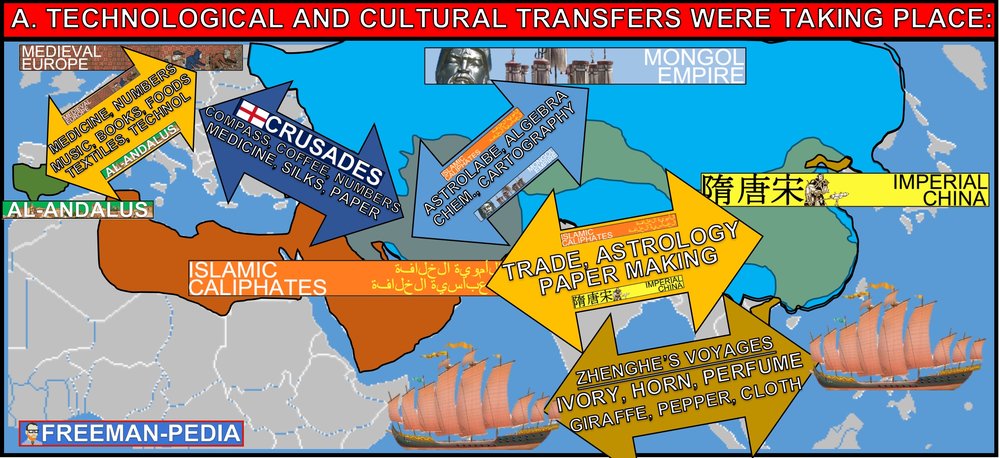
KEY CONCEPT 3.3: INCREASED ECONOMIC PRODUCTIVE CAPACITY & ITS CONSEQUENCES
Changes in trade networks resulted from and stimulated increasing productive capacity, with important implications for social and gender structures and environmental processes. Productivity rose in both agriculture and industry. Rising productivity supported population growth and urbanization but also strained environmental resources and at times caused dramatic demographic swings. Shifts in production and the increased volume of trade also stimulated new labor practices, including adaptation of existing patterns of free and coerced labor. Social and gender structures evolved in response to these changes.
1. Innovations stimulated agricultural and industrial production in many regions.

Agricultural production increased significantly due to technological innovations (Champa rice varieties, chinampa field systems, Waru waru agricultural techniques in the Andean areas, Improved terracing techniques, horse collar)
- In response to increasing demand in Afro-Eurasia for foreign luxury goods, crops were transported from their indigenous homelands to equivalent climates in other regions.
- Chinese, Persian, and Indian artisans and merchants expanded their production of textiles and porcelains for export; industrial production of iron and steel expanded in China.
2. The fate of cities varied greatly, with periods of significant decline, and with periods of increased urbanization buoyed by rising productivity and expanding trade networks.
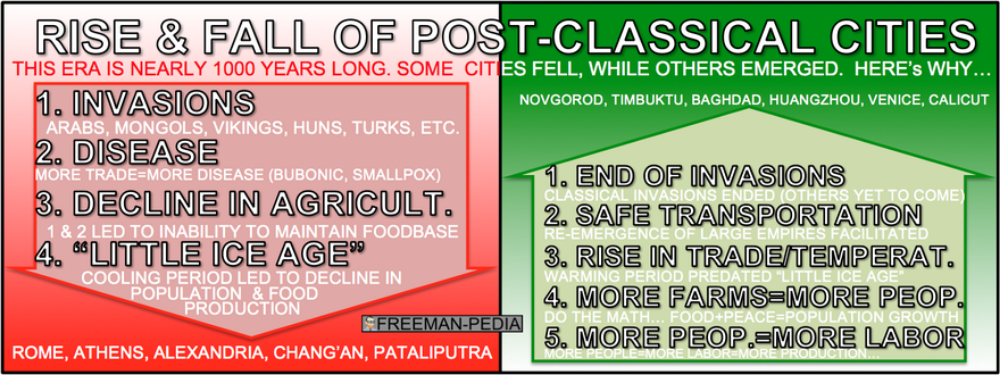
Click Image for more information . . . .
While cities in general continued to play the roles they had played in the past as governmental, religious, and commercial centers, many older cities declined at the same time that numerous new cities emerged to take on these established roles.
Students should be able to explain the cultural, religious, commercial and governmental function of at least two major cities.
The Little Ice Age is tied directly to the decline in urban population.
3. Despite significant continuities in social structures and in methods of production, there were also some important changes in labor management and in the effect of religious conversion on gender relations and family life.

Click Image for more information . . .
A. As in the previous period, there were many forms of labor organization. Required examples of forms of labor organization
-Free peasant agriculture
-Nomadic pastoralism
-Craft production and guild organization
-Various forms of coerced and unfree labor
-Government-imposed labor taxes
-Military obligations
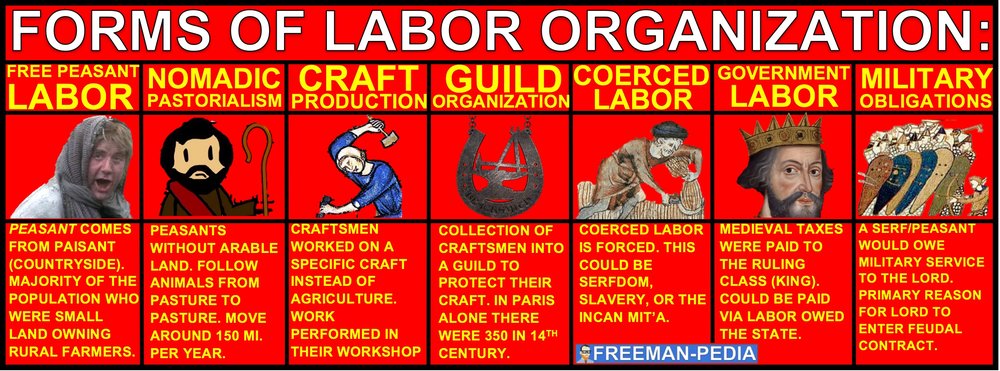
B. As in the previous period, social structures were largely shaped by class and caste hierarchies, although patriarchy persisted.
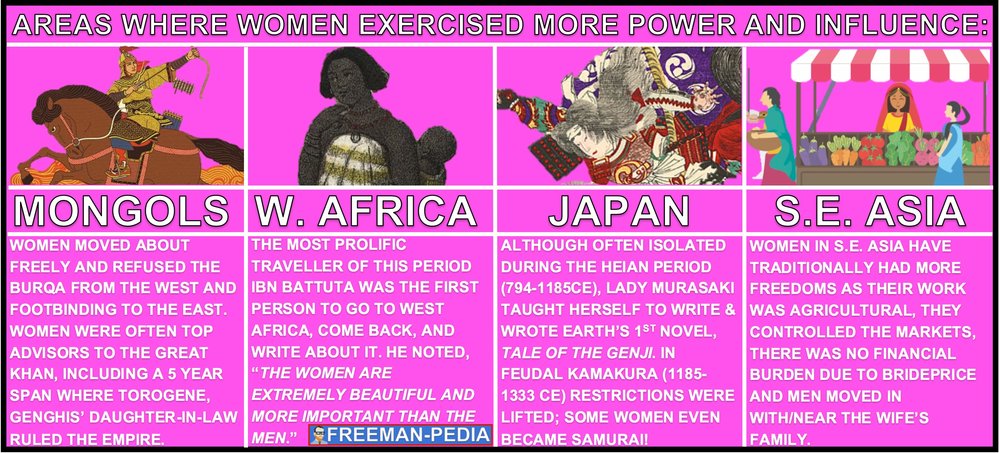
C. Free peasants resisted attempts to raise dues and taxes by staging revolts. The demand for slaves for both military and domestic purposes increased, particularly in central Eurasia, parts of Africa, and the eastern Mediterranean. One illustrative example of regions where free peasants revolted either from the list below or an example of your choice:
- China
-The Byzantine Empire
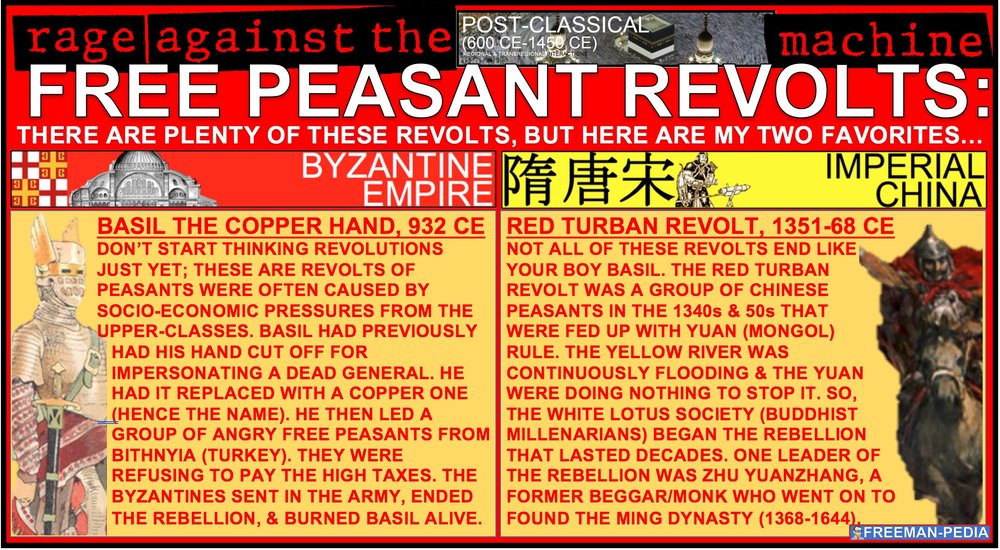
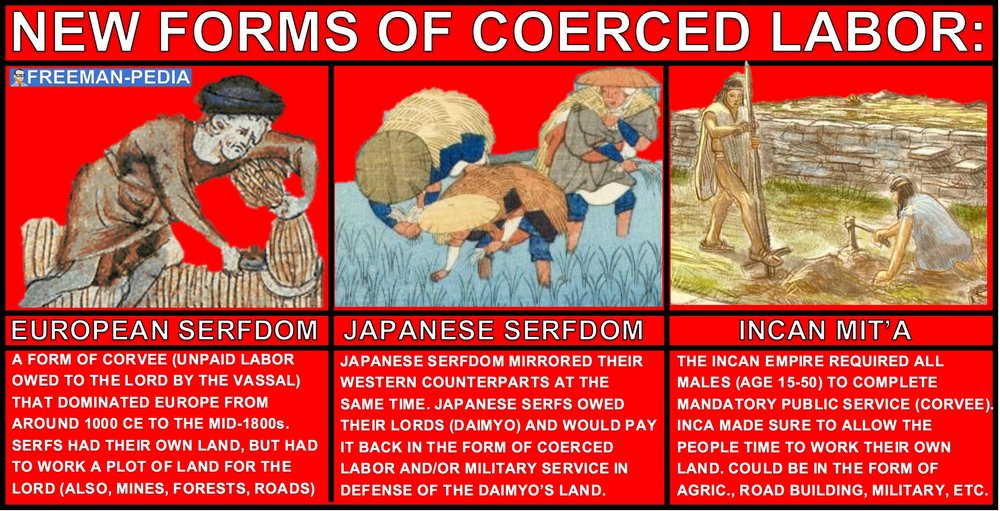



- EDICT on BUDDHISM, c. 845, Emperor Wuzong, (CHINA)
- CHARTER of FEALTY, 1110, Monk John (FRANCE)
- 1,001 ARABIAN NIGHTS, c. 1200, (ARABIA)
- EPIC of SUNDIATA, c. 1300 (MALI)
- TRAVELS in AFRICA & ASIA, 1354, Ibn Battuta (MOROCCO)
Videos and Links


The Following sites and materials are useful in reviewing the content of this unit
Freemanpedia => Unit III Review materials

Download these review materials and more HERE at Freemanpedia's site
Source: https://www.room13.org/unit-iii-the-postclassical-era